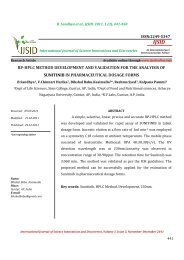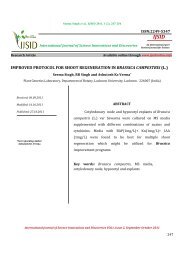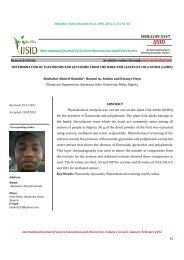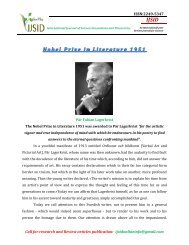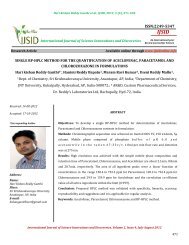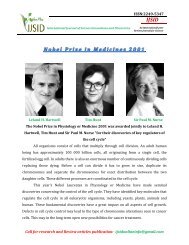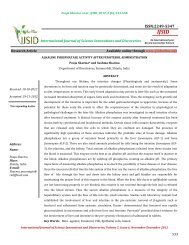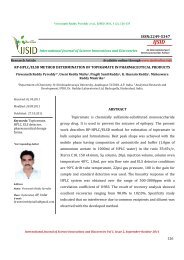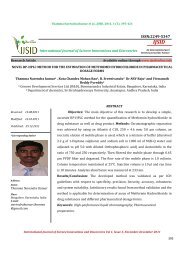(fab.) (lepidoptera: noctuidae) larvae - Ijsidonline.info
(fab.) (lepidoptera: noctuidae) larvae - Ijsidonline.info
(fab.) (lepidoptera: noctuidae) larvae - Ijsidonline.info
You also want an ePaper? Increase the reach of your titles
YUMPU automatically turns print PDFs into web optimized ePapers that Google loves.
Evaluation of insecticide efficacy in bioassaysMahadev C Khetagoudar et al., IJSID, 2012, 2 (1), 12-22Required concentrations of the extracts (viz.,1, 2, 3, 5, 7.5, 12.5, 15 and 17.5%) were prepared from stock solutionseparately. Two ml of the extracts were sprayed on the fourth instar <strong>larvae</strong> of S. litura with the help of a glass automiser.Untreated checked <strong>larvae</strong> were sprayed with 2 ml of distilled water alone. Twenty, fourth instar <strong>larvae</strong> were maintained pertreatment and each treatment was replicated three times. The sprayed <strong>larvae</strong> were transferred to transparent plasticcontainers of 4 x 2.5 cm size capped with perforated plastic lids and allowed to fed with sufficient quantity of castor leaves.Observations were recorded every day.Observations recordedMortality was recorded at 24 hours of intervals. Larval, pupal, adult mortality and deformities in the surviving treatedindividuals were carefully observed and recorded. Percent mortality observed in the control groups if any were corrected byusing Abbott’s formula (Abbott, 1925):Number of dead <strong>larvae</strong>Percentage of mortality = ———————————— x 100Number of <strong>larvae</strong> introducedn in T after treatmentCorrected percentage of mortality = {1 - ——————————} x 100n in C after treatmentWhere, n is the number of <strong>larvae</strong>, T is the treated group and C is the control group.Adult emergence inhibition (EI) effectThe method of the insecticidal activity was followed. Mortality of the <strong>larvae</strong> and pupae were recorded at 24 hrinterval. At the end of observation period, the impact is expressed as EI % based on the number of <strong>larvae</strong> that do not developsuccessfully into viable adults. The experiments stopped when all the <strong>larvae</strong> or pupae in the controls have died or emerged asadults. Emergence inhibition (EI) was calculated using the Finney’s formula (Finney 1971) :No. of pupae emerged into adults% inhibition of adult emergence = 100 – ----------------------------------------- × 100Total no. of pupaeData analysisThe interpretation of analytical data was performed by application of Analysis of Variance (ANOVA) using a factorialCompletely Randomized Design (CRD).ResultsThe table 1. provided the comparative account of the three crude aqueous extracts on the total percent mortality atvarious concentrations of C. inerme, E. triplinerve and V. negundo. It was very evident that the V. negundo comparatively wasmore effective than the C. inerme and E. triplinerve (Graph .4). The range of toxicity was in the order of V.negundo > E.triplinerve > C. inerme.Among the three extracts tested for, the crude extract of C. inerme at higher concentration (7.5 to 17.5) appear to be morepotent than that of V.negundo and E. triplinerve. It may be observed that C. inerme extract at high level produced the percentmortality in the range of 11 percent to 15 percent whereas V. negundo and E. triplinerve showed the percent mortality in therange of 3 to 11.66 percent and 6.66 percent respectively. Comparative account of the larvicidal effect of three plant extracts issummarized in table 2.It was further noted that the percent pupal mortality in respect of the treatment of three extracts it maybe suggested that there was no significant difference among the three extracts tested for. Comparative account of the pupalInternational Journal of Science Innovations and Discoveries, Volume 2, Issue 1, January-February 201215
Mahadev C Khetagoudar et al., IJSID, 2012, 2 (1), 12-22mortality of three plant extracts tabulated in table. 3. The present experiments were also extended to determine the adultemergence inhibition (EI) of the <strong>larvae</strong> treated with crude aqueous extracts of C. inerme, E.triplinerve and V. negundo (table 4).Table-1.Percent total mortality of Spodoptera litura F. after spraying with aqueous extracts of Clerodendron inerme,Eupatorium triplinerve and Vitex negundo leaves following the treatment on fourth instar <strong>larvae</strong>.TreatmentPercentPercent total mortality mean±S.E.ConcentrationC. inerme E. triplinerve V. negundoT 1 1 43.33±8.81 48.33±10.13 56.66±1.66T 2 2 51.66±9.27 63.31±4.40 61.66±1.66T 3 3 60.00±5.00 73.32±1.66 68.33±15.89T 4 5 78.33±3.33 86.65±10.92 90.00±2.88T 5 7.5 80.00±2.88 88.32±9.27 94.97±3.33T 6 12.5 88.33±10.13 91.65±1.66 96.66±3.33T 7 15 87.48±8.81 92.32±9.27 95.98±15.89T 8 17.5 88.32±5.00 91.65±9.27 96.65±6.66T 9Distilled watercontrol13.33±1.66 11.65±1.66 18.33±4.40T 10 Absolute control 0 0 0Table-2. Percent total larval mortality of Spodoptera litura F. after spraying with aqueous extracts of Clerodendron inerme,Eupatorium triplinerve and Vitex negundo leaves following the treatment on fourth instar <strong>larvae</strong>.Treatment Percent ConcentrationPercent total larval mortalityC. inerme E. triplinerve V. negundoT 1 1 20 3.33 8.32T 2 2 5 40 21.66T 3 3 5 10 10T 4 5 1.66 0 6.66T 5 7.5 15 0 5T 6 12.5 11.66 6.66 11.66T 7 15 11.66 0 3.33T 8 17.5 11.66 6.66 5.0T 9 Distilled water control 5 1.66 8.33T 10 Absolute control 0 0 0Table-3. Percent total pupal mortality of Spodoptera litura F. after spraying with aqueous extracts of Clerodendron inerme,Eupatorium triplinerve and Vitex negundo leaves following the treatment on fourth instar <strong>larvae</strong>.Treatment Percent ConcentrationPercent total pupal mortalityC. inerme E. triplinerve V.negundoT 1 1 23 45 48T 2 2 46 11 40T 3 3 54 56 50T 4 5 65 75 56T 5 7.5 65 64 63T 6 12.5 71 75 78T 7 15 71 66 65T 8 17.5 66 72 73T 9 Distilled water control 8 10 10T 10 Absolute control 0 0 0# Results are corrected to round of figures.The results revealed that the EI 50 of V. negundo was more effective at lower concentration (2.09%) than that of theother two extracts, C. inerme and E.triplinerve, which exhibited 3.16 and 4.07% respectively. Interestingly the calculated EI 90values for V.negundo was 12.6% when compared to the other two extracts namely C. inerme 30.98 % and E. triplinerve 14.16%. However between the C. inerme and E. triplinerve, the E. triplinerve requires less concentration (14.10%) than that ofInternational Journal of Science Innovations and Discoveries, Volume 2, Issue 1, January-February 201216
Mahadev C Khetagoudar et al., IJSID, 2012, 2 (1), 12-22C.inerme (30.98%). It was deduced from these results that the EI 90 of E.triplinerve required 14.10 % less than that of C. inerme30.98 %, which were not consistent with EI 50 values, wherein C. inerme requires less (3.16%) than that of E. triplinerve(4.07%).Table-4. Comparative account of emergence inhibition of Spodoptera litura following the treatment of crude aqueous extractsof Clerodendron inerme, Eupatorium triplinerve and Vitex negundoAdult Emergence inhibition C.inerme E. triplinerve V. negundoEI 50 3.164.072.09Discussion(2.30 to 3.97)(1.39 to 6.63)EI 90 30.9814.10(21.94 to 52.66)(8.34 to 81.16)The values in the parentheses indicate the confidential limits at 95%.(0.64 to 3.36)12.56(8.05 to 35.93)Prohibitive expense to meet the challenges of increasing resistance in insects, resurgence of pests and escalatingenvironmental pollution caused by synthetic pesticides call for the discovery of less-expensive, nonhazardous alternatives inthe management of insect-pests. Naturally occurring insecticides may play a more prominent role in pest control programs inthe future (Mordue and Blackwell 1993). Because plants produce a wide spectrum of allelochemicals, that specifically inhibitgrowth, morphogenesis, metamorphosis and reproduction (Ahmad, 2007). Growth disruptive activity of three plants extractsnamely C.inerme, E.triplinerve and V.negundo against fourth instar of S. litura was very evident from the present investigation.The comparative data of larval and pupal mortality revealed that the larvicidal effect of all the three extracts wassignificantly less than their toxic effect during the pupal stage. Similar results were reported in crude extract with specificmode of action against insects is a complex mixture of compounds (Tewary et al., 2005). Many researchers have reportedcrude extracts on S. litura (Raja et al., 2005; Kamaraj et al., 2008). On the basis of these results it may be argued that the lessereffect of the crude extract during larval stage may be due to the development of requisite biochemical strategies against thevarious biochemical components present in the crude extracts tested in this study.Our data obtained form the adult emergence inhibition calculation is in accordance with the findings of Oigiangbe etal. (2007) who obtained EI 50 value at 3.5% concentration with leaf extract of Alstonia boonei on Sesamai calamistis. Pavela(2004) observed EI 50 value of 3.74 % in Melissa officinalis on S. littoralis. The adult emergence inhibition activity of C.inerme isalso comparable to different species of plant extract in different families (Muthukrishnan et al.,1999).The toxic effect of the three crude extracts during the pupal stage was significantly higher. During this stage they donot feed and the body shrinks in size and they are in quiescent state. Insecticidal property of 10 % V. negundo extracts werereported earlier by Sahayaraj (1998). Experiments conducted by Singh et al. (2005) also reveled insecticidal properties ofmethanol extracts of ginger in which they got 78.9 % mortality when the <strong>larvae</strong> of Earias vittella were treated with 10 %concentration of methanol extract of ginger. Dayrit et al. (1995) had recorded that topical application of volatile oils of V.negundo caused 91 % mortality in third instar <strong>larvae</strong> of S. litura. Thin layer chromatography studies revealed that alkaloids,saponin and flavonoids were present in the leaf of V. negundo (Sahare et al., 2008).The extracts of V. negundo, C. inerme, L.camara, and E.odoratum caused high mortality against A. janata, P.xylostella and S. litura <strong>larvae</strong> in the laboratory assay(Kulkarni, 2002; Yankanchi, 2003).International Journal of Science Innovations and Discoveries, Volume 2, Issue 1, January-February 201217
Mahadev C Khetagoudar et al., IJSID, 2012, 2 (1), 12-22Fig-1 Histogram showing comparative account of bioefficacy of crude aqueous extracts of Clerodendron inerme, Eupatoriumtriplinerve and Vitex negundo on fourth instar <strong>larvae</strong> of Spodoptera litura F.CONCLUSIONIn conclusion, the study revealed that the leaf extracts of C. inerme, E. triplinerve and V. negundo possess remarkablelarvicidal and adult emergence inhibition activity against S. litura F. Further investigations are needed to elucidate this activityagainst a wide range of insect pests and also the active ingredient(s) and its biomolecule characterization for the better actionagainst the pest under field conditions. It is possible to extract these substances if they have good environmental stability andare environmentally safe, and to use these extracts as botanical insecticides in plant protection. For this reason, botanicalinsecticides can be recommended as suitable to provide the protection of crops against common phytophagous pests in allcrop growing systems.ACKNOWLEDGEMENTSAuthors are thankful to Dr. S.N.Holihosur, Professor, Dept of Zoology, Karnataka University, Dharwad, India forproviding necessary Laboratory facilities and valuable guidance throughout the entire study.REFERENCES1. Abbott WS (1925) A method for computing the effectiveness of an insecticide J Econ Ent 18:265-267.2. Abudulai M, Shepard BM, Mitchell PL (2001) Parasitism and predation on eggs of Leptoglossus phyllopus (L.)(Hemiptera:Coreidae) in cowpea: impact of endosulfan sprays. J Agric Urban Entomol 18:105–115International Journal of Science Innovations and Discoveries, Volume 2, Issue 1, January-February 201218
Mahadev C Khetagoudar et al., IJSID, 2012, 2 (1), 12-223. Ahmed, S., Grainage, M., Hylin, J.W. Mitchell, W.C. and Litsinger, J.A. 1984. Some promosing plant species for use as pestcontrol agents under traditional faming systems. Proceedins of the 2 nd International Neem Conference 1983. 565-580.Rauischholzhausen, Germany.4. Ahmad M, Arif MI, Ahmad M. 2007. Occurrence of insecticide resistance in field populations of Spodoptera litura(Lepidoptera: Noctuidae) in Pakistan. Crop Protection 26: 809-8175. Ahmad M., 2007. Insecticide resistance mechanisms and their management in Helicoverpa armigera (Hübner), a review. JAgric Res 45, 319-335.6. Akthar Y., Yeoung Y.R., Isman M.B., 2008. Comparative bioactivity of selected extracts from Meliaceae and somecommercial botanical insecticides against two noctuid caterpillars, Trichoplusia ni and Pseudaletia unipuncta. PhytochemRev 7, 77-88.7. Aliero, B.L. (2003). Larvicidal effects of aqueous extracts of Azadirachta indica (neem) on the <strong>larvae</strong> of Anophelesmosquito. Afri. J. Biotech. 2(9), 325-327.8. Amin,, P. W., Major fi eld and storage insect pests of groundnut in India and their control. Occasional paper 1/83,Groundnut improvement programme, ICRISAT, Patancheru, Hyderabad (1983).9. Armes NJ, Wightman JA, Jadhav DR, Rao GVR. 1997. Status of insecticide resistance in Spodoptera litura in AndhraPradesh,India. Pesticide Science 50:240–248.10. Baskar, K., S. Kingsley, E.S. Vendan, M.G. Paulraj and S. Ignacimuthu, 2009. Antifeedant, larvicidal and pupicidal activities ofAtalantia monophylla (L) Correa against Helicoverpa armigera Hubner (Lepidoptera: Noctuidae). Chemosphere, 75:355-359.11. Bai, S.K.and Kundaswamy, C., 1985, Laboratory induced mortality of Spodoptera litura (F.) fed on the leaf discs of castortreated with the extracts of Vitex negundo Linn. And Stachytarpheta urticifolia (Salish) Sims. Indian Journal of AgriculturalSciences, 55: 760-761.12. Brown ES, Dewhurst CF (1975) The genus Spodoptera in Africa and the Near East. Bull Entomol Res 65:221–262.13. Ciccia, G., J. Coussio and E. Monelli, 2000. Insecticidal activity against Aedes aegypti <strong>larvae</strong> of some m e d i c i n a l SouthAmeric an pla nts. J Ethnopharmacol., 72: 185-189.14. Chari, M.S. and Patel, N.G., 1983, Cotton leafworm, Spodoptera litura (Fab.)- its biology and integrated control measures.Cott. Dev.13: 7-8.15. Chari M. S., Patel N. G., Effi cacy of some newer insecticides against the tobacco leaf-eating caterpillar,Spodoptera litura(Fabricius), Indian J. Entomol.(1972) 34: 261 - 262.16. David, B. V., Sukumaran, D., and Kandasamy, C. (1988). The Indian privet Vitex negundo Linn- A plant processing promisingpesticidal activity. Pesticide J. 27-30.17. Dayrit, F. M., Corazon, M., Trono, M., Rejesus, B.M. and Maini, H. 1995. Anti-pest compounds from the volatile oil of Vitexnegundo Lin. Philippines Journal of Sciences, 124(1): 15-27.18. Dev. S and Koul, O. (1997). Insecticides of Natural Origin. Amsterdam: Harwood Acad. 363 pp.19. Deota PT, Upadhyay PR (2005) Biological studies of azadirachtin and its derivatives against polyphagous pest, Spodopteralitura. Nat Prod Res 19:529–539.20. Elumalai, K., Dhanasekaran, S., Veeraiyan, G and Meenakshi. V. 2008. Feeding deterrent activity of certain plant extractsagainst the fruitborer, Helicoverpa armigera (Hubner). Applied Zoological Research. 19 (2): 133 – 138.International Journal of Science Innovations and Discoveries, Volume 2, Issue 1, January-February 201219
Mahadev C Khetagoudar et al., IJSID, 2012, 2 (1), 12-2221. Finney, D.J. (1971). Probit Analysis, third ed. Cambridge University press London U K pp 383.22. Ferry N, Edwards MG, Gatehouse JA, Gatehouse AMR (2004) Plant– insect interaction: molecular approaches to insectresistance (edited by Sasaki T, Christou P). Curr Opin Biotechnol 15:155–16123. Deota PT, Upadhyay PR (2005) Biological studies of azadirachtin and its derivatives against polyphagous pest, Spodopteralitura. Nat Prod Res 19:529–53924. Gaillce Leo J. C., Je Adeline, V. J. (2003). Prem Joshua and M. Jayasekhar, Laboratory evaluation of some botanicals againstthe diamond back moth, Plutella xylostella (L) (Lepidoptera: Plutellidae). Pest Management and Econ. Zool. 11(2), 177-181.25. Grainge and Ahamed. (1985). Handbook of plants with Pest control properties. 470-502.26. Holloway JD (1989) The moths of Borneo: Family Noctuidae,trifine subfamilies: Noctuinae, Heliothinae, Hadeninae,Acronictinae, Amphipyrinae, Agaristinae. Malay Nat J 42:57–226.27. Holihosur, S.N., Lingappa, S., and Kulgod, R.V. (1993). Insecticidal potential of some of the plant extracts against CastorSemilooper, Achaea janata L. Annual Report of the U.G.C sponsored Research Project No. F-3 –123 89 (SR II), Department ofAgricultural Entomology, UAS Dharwad.28. Jagan, L., Mohan, R., Pereira, J., and Gurudutt, K. N. (1993). Neo-clerondendron diterpenes from Clerodendron inerme.Phytochemistry, 34(2), 572-574.29. Huang SJ, Han ZJ. 2007. Mechanisms for multiple resistances in field populations of common cutworm, Spodoptera litura(Fabricius) in China. Pesticide Biochemistry and Physiology 87: 14-22.30. Kamaraj, C., Rahuman, A.A. and Bagavan, A. (2008). Antifeedant and larvicidal effects of plant extracts against Spodopteralitura (F.), Aedes aegypti L. and Culex quinquefasciatus Say. Parasitology Research 103:325–33.31. Kranthi KR, Jadhav DR, Wanjari RR, Ali SS, Russell DA. 2001. Carbamate and organophosphate resistance in cotton pestsin India, 1995 to 1999. Bulletin of Entomological Research 91:37–46.32. Kranthi, K.R., Jadhav, D.R., Kranthi, S., Wanjari, R.R., Ali, R.R. and Russell, D.A., 2002, Insecticide resistance in five majorinsect pests of cotton in India, Crop Prot. 21: 449-460.33. Koul, O and Dhaliwal, G.S. 2001. Phytochemical Biospecticides. Amsterdam: Harwood Acad. 223 pp.34. Kulkarni, R. D. (2002). Formulation of botanical insecticides. Ph.D Thesis, Karnatak University, Dharwad.35. Kaushik, N and Kathuria, V. 2004. Helicoverpa (Heliothis) and botanical pesticides: an overview In:Prasad, D. & Singh, A.(Eds) Advances in Plant Protection Sciences. 156-166. Akansha publishing House, Darya, Ganj, New Delhi, India.36. Muthukrishnan J., Seifert K., Hoffmann K.H.,Lorenz M.W. (1999): Inhibition of juvenile hormone biosynthesis in Gryllusbimaculatus by Glycosmis pentaphylla leaf compounds. Phytochemistry. 50, 249-254.37. Murugesan, K. and Dhingra, S., 1995, Variaility in resistance pattern of various groups of insecticides evaluated againstSpodoptera litura (Fabricius) during a period spanning over three decades. J. Ent. Res., 19: 313-319.38. Mordue (Luntz), A.J and Blackwell, A. 1993. Azadirachtin: an update. Journal of Insect Physiology 39: 903-924.39. Makrotra K.N., Pesticide resistance in insect pests - Indian Scanario, Pesti. Res. Journal, (1989) 1: 93 – 103.40. More, G.N., Kadu, N.R. and Sakhare, S.D., 1989, Nagpur Agriculture College Magazine, 56:49-5141. Nayak S.K., Chhibber R.C., Evaluation of relative toxicity of endosulfan and methyl chlorpyriphos against Spodoptera litura(Fab.), Shaspha. (2002) 9 (2): 191 – 19342. Nasir, E. and S.I. Ali. 1974. Flora of West Pakistan; Verbenaceae, No.77 complied by S.M.H.Jafri, Abdul Ghafoor, Herbarium,Department of Botany, University of Karachi.International Journal of Science Innovations and Discoveries, Volume 2, Issue 1, January-February 201220
Mahadev C Khetagoudar et al., IJSID, 2012, 2 (1), 12-2243. Naumann K, Isman MB (1995) Evaluation of neem Azadirachta indica seed extracts and oils as oviposition deterrents tonoctuid moths. Entomol Exp Appl 76:115–120.44. Naumann K, Isman MB (1995) Evaluation of neem Azadirachta indica seed extracts and oils as oviposition deterrents tonoctuid moths. Entomol Exp Appl 76:115–12045. Pandey, S. K., and Mehroz, B. K. (2000). Effect of Clerodendron siphonathus leaf extract on the adaptability byCallosobruchus chinensis to its own population density46. through dipping method. Indian J. Ent. 62(2), 133-14047. Pavela, R. (2004). Insecticidal activity of certain medicinal plants. Fitoterapia 75: 745-749.48. Pugazhvendan, S. R., Elumalai, K., Ronald Ross, P and Soundarajan, M. 2009. Repellent activity of chosen plant speciesagainst Tribolium castaneum. Wolrd J. Zool. 4(3): 188 – 190.49. Prajapati, V.,Tripathi, A.K.,Khanuja, S.P.S., Kumar,S., Pharma. Biol. 2003, 41, 166-170.50. Patil, P. B. (2003). Biology of Aedes aegypti L. and its possible control using Clerodendron inerme Geartn. leaves. M.PhilDissertation.51. Oigiangbe, O.N., Igbinosa, I.B. and Tamo, M. (2007). Insecticidal activity of the medicinal plant, Alstonia boonei De Wild,against Sesamia calamistis Hampson. Journal of Zhejiang University Science B 8: 752-755.52. Qin HG, Ye ZX, Huang SJ, Li H. 2000. Research on the damage by tobacco caterpillar (Prodenia litura Fabricius) to cottonand the control threshold. China Cotton 27(4):24–25.53. Qin HG, Ye ZX, Huang SJ, Ding J, Luo RH. 2004. The correlations of the different host plants with preference level, lifeduration and survival rate of Spodoptera litura Fabricius. Chinese Journal of Eco-Agriculture 12(2):40–42.54. Raja, N., Jeyasankar, A., Jeyakumar, S.V. and Ignacimuthu. S. (2005). Efficacy of Hyptis suaveolens against Lepidopteranpest. Current Science 88:220-222.55. Ranakrishnan N, Saxena VS, Dhingra S. 1984. Insecticide resistance in the population of Spodoptera litura (Fab.) in AndhraPradesh. Pesticides 18:23–27.56. Rao GVR, Wightman JA, Ranga Rao DV. 1993. World review of the natural enemies and diseases of Spodoptera litura (F.)(Lepidoptera:Noctuidae). Insect Science and its Application 14: 273-284.57. Rodriguez-Saona, C.R. and J.T. Trumble, 1999. Effect of avocado furans on larval survival, growth and food preference ofthe generalist herbivore, Spodoptera exigua. Entomol. Exp. Appl., 90: 131-140.58. Regnault-Roger, C., Philogene, B and Vincent, C. 2005. Biopesticides of Plant Origin. Paris: Lavoisier. pp.313.59. Rodríguez, C., Silva, G., Djair, V., 2003. Bases para el manejo racional de insecticidas: Insecticidas de origen vegetal.Facultad de Agronomía, Universidad de Concepción, y Fundación para la Innovación Agraria, Concepción, Chile.60. Rout, G. (1986). Comparative efficacy of neem seed powder and some plant product admixtures against Sitophilus oryzae(Linn). Neem News Letter 3(20), 13-14.61. Regnault-Roger, C., Staff, V., Philogène, B., Terrón, P., Vincent, C., 2004. Biopesticidas de origen vegetal. Ediciones Mundi-Prensa, Madrid.62. Singh, D. 2000. Bioinsecticides from plants. Current Science 78: 7-8.63. Sastri, B.N. 1950. The Wealth of India, A Dictionary of Raw Material and Industrial Products.Publication and <strong>info</strong>rmationdirectorate CSIR New Delhi, 5: 285-293.International Journal of Science Innovations and Discoveries, Volume 2, Issue 1, January-February 201221
Mahadev C Khetagoudar et al., IJSID, 2012, 2 (1), 12-2264. Senthil Nathan, S. and Kalaivani, K. (2005). Efficacy of nucleopolyhedrovirus (NPV) and azadirachtin on Spodoptera lituraFabricius (Lepidoptera :Noctuidae). Biological Control 34: 93-98.65. Sadek, M. M. 2003. Antifeedant and toxic activity of Adhatoda vasica leaf extract against Spodoptera littoralis (Lepidoptera:Noctuidae). Journal AppliedEntomology, 27: 396-404.66. Sadek, M.M., 1997. Antifeedant and larvicidal activity effects of Eichornia crassipes leaves on the cotton leaf wormSpodoptera littoralis (Boisd). J. Egypt Ger. Soc. Zool., 24: 209-232.67. SAHAYARAJ, K. AND SEKAR, R., 1996, Efficacy of plant extracts against tobacco caterpillar <strong>larvae</strong> in groundnut.International Arachis Newsletter, 16:38.68. Sahayaraj, K. 1998. Antifeedant effect of some plant extracts on the Asian armyworm, Spodoptera litura(Fabrious). CurrentScience, 74: 523-525.69. Sahayaraj, K., Selvaraj P. and Raju G. (2003). Evaluation of Bio-pesticidal of property of Christella parasitica and Ipomoeacornea on Achae janata Linn. Journal of Applied Zoological Research 14(1): 48-50.70. Shi W, Yao WP, Liu DG. 2003. Analysis of the main facts influencing the outbreak of Spodoptera litura (Fab.) and thecontrol measures. Bulletin of AnHui Agronomy (6):106–107.71. Shetty, S. R. (2005). The laboratory evaluation of the toxicity of Clerodendron inerme Gaertn. against immature stages ofCulex quinquefasciatus Say. M.Phil. Dissertation, Karnatak University, Dharwad.72. Singh, D., Lal, R. and Singh, R. 2005. Insecticidal properties of ginger, Zingiber officianale against Earias vitella Fab.Pesticide Research Journal, 17 (2): 21-25.73. Saxena R. C., 1998. Botanical pest control, in: Dhaliwal G.S., Heinrichs (Eds.), Critical issues in insect pest management,Commonwealth Publisher, New Delhi, India, 1998, pp.155 – 179.74. Tapondiou, A.I., C. Adler, D.A. Fontem, H. Bouda and C.H. Reichmuthu, 2005. Bioactivities of cymol and essential oils ofCupressus sempervirens and Eucalyptus saligna against Sitophilus zeamais Motschulsky and Tribolium confusum du Val.J.Stored Prod. Res., 41: 91-102.75. Tewary, D.K., Bhardwaj, A. and Shankar, A. (2005). Pesticidal activities in five medicinal plants collected from mid hills ofwestwern Himalayas. Industrial Crops and Products 22: 241-247.76. Ulrichs, C.H., I. Mews, S. Adhikary, A. Bhattacharyya and A. Goswami, 2008. Antifeedant activity and toxicity of leaf extractsfrom Portesia coarctata Take77. Wu SC, Gu YZ, Wang DS. 1995. Resistance of the tobacco armymoth (Prodenia litura) to insecticides and its control. ActaAgriculturae Shanghai 11(2):39–43.78. Wheeler, D.A. and Isman, M.B., 2001, Antifeedant and toxic activity of Trichilia americana extract against the <strong>larvae</strong> ofSpodoptera litura. Ent. Exper. et Applic., 98: 9-16.79. Whalon ME, Mota-Sanchez D, Hollingworth RM, Duynslager L (2007) Spodoptera litura. In: Arthropod pesticide resistancedatabase. Michigan State University. Available via DIALOG. 12/282/0/Spodoptera litura. Cited Jan 200780. Yanakanchi, S. R. (2003). Studies on the insecticidal properties of certain plant extracts. Ph.D Thesis, Karnatak UniversityDharwad.81. Zhou TM. 1984. Monitoring of the resistance in common cutworm Spodoptera litura (Lepidoptera: Noctuidae) to fourclasses of insecticides. Agricultural Research in China 33(3): 331–339.International Journal of Science Innovations and Discoveries, Volume 2, Issue 1, January-February 201222





